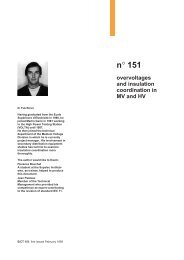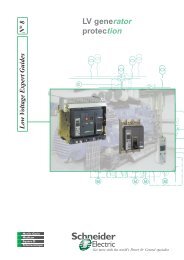sepam 20 user manual - Schneider Electric
sepam 20 user manual - Schneider Electric
sepam 20 user manual - Schneider Electric
Create successful ePaper yourself
Turn your PDF publications into a flip-book with our unique Google optimized e-Paper software.
Modbus communication Disturbance recording<br />
Presentation<br />
The disturbance recording function is used to record<br />
analog and logical signals during a time interval.<br />
Sepam can store two records.<br />
Each record comprises two files:<br />
b configuration file with suffix .CFG<br />
b data file with suffix .DAT.<br />
The data of each record may be transferred via the<br />
Modbus link. It is possible to transfer 1 or 2 records to a<br />
remote monitoring and control system. The record may<br />
be transferred as many times as possible, until it is<br />
overwritten by a new record.<br />
If a record is made by Sepam while the oldest record is<br />
being transferred, the oldest record is altered.<br />
If a command (e.g. a remote reading or remote setting<br />
request) is carried out during the transfer of a<br />
disturbance recording record, the record is not<br />
disturbed.<br />
Time-setting<br />
Each record can be dated.<br />
Time-setting of Sepam is described in the "Timetagging<br />
of events" section.<br />
Transferring records<br />
The transfer requests are made record by record, i.e.<br />
one configuration file and one data file per record.<br />
The master sends the commands in order to:<br />
b find out the characteristics of the records stored in an<br />
identification zone<br />
b read the contents of the different files<br />
b acknowledge each transfer<br />
b reread the identification zone to ensure that the<br />
record still appears in the list of records available.<br />
PCRED301005EN - 06/<strong>20</strong>08<br />
Reading the identification zone<br />
Given the volume of data to be transmitted, the master must ensure that there are<br />
data to be recovered and prepare the exchanges when necessary.<br />
The identification zone, described below, is read by the reading of N words starting<br />
at the address 2<strong>20</strong>4h:<br />
b 2 reserve words forced to 0<br />
b size of record configuration files encoded in 1 word<br />
b size of record data files encoded in 1 words<br />
b number of records encoded in 1 word<br />
b date of record (most recent) encoded in 4 words (see format below)<br />
b date of record (least recent) encoded in 4 words (see format below)<br />
b 24 reserve words.<br />
All of these data are consecutive.<br />
Reading the contents of the different files<br />
Request frame<br />
The master makes the request by writing the date of the record to be transferred<br />
(function 16) in 4 words starting at the address 2<strong>20</strong>0h.<br />
It should be noted that requesting a new record amounts to stopping the transfers<br />
which are in progress. This is not the case for an identification zone transfer request.<br />
2<strong>20</strong>0h<br />
B15 B14 B13 B12 B11 B10 B09 B08 B07 B06 B05 B04 B03 B02 B01 B00<br />
O O O O O O O O Y Y Y Y Y Y Y Y<br />
O O O O M M M M O O O D D D D D<br />
O O O H H H H H O O mn mn mn mn mn mn<br />
ms ms ms ms ms ms ms ms ms ms ms ms ms ms ms ms<br />
Y - 1 byte for years: varies from 0 to 99 years.<br />
The master must ensure that the year 00 is later than 99.<br />
M - 1 byte for months: varies from 1 to 12.<br />
D - 1 byte for days: varies from 1 to 31.<br />
H - 1 byte for hours: varies from 0 to 23.<br />
mn - 1 byte for minutes: varies from 0 to 59.<br />
ms - 2 bytes for milliseconds: varies from 0 to 59999.<br />
Reply frame<br />
Reading of each portion of configuration and data file records by a reading frame<br />
(function 3) of 125-words starting at the address 2300h.<br />
2300h<br />
B15 B14 B13 B12 B11 B10 B09 B08 B07 B06 B05 B04 B03 B02 B01 B00<br />
Exchange number<br />
..............<br />
Data zone<br />
..............<br />
Number of usable bytes<br />
in the data zone<br />
Reading should always begin with the first word in the address zone (any other<br />
address triggers an exception reply "incorrect address").<br />
The configuration and data files are read in their entirety in Sepam. They are<br />
transferred adjacently.<br />
5/31<br />
5

















